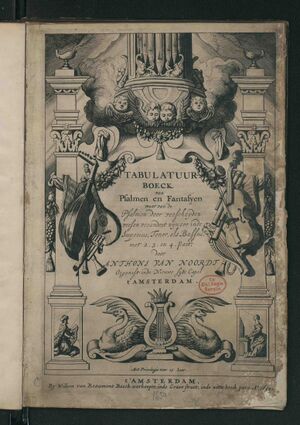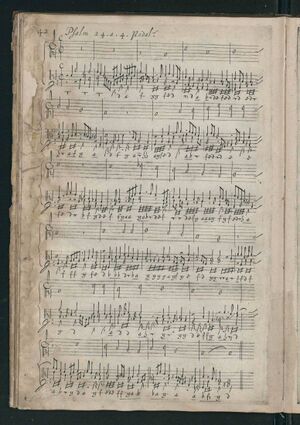Anthoni van Noordt
Anthoni van Noordt (1619-1675) was a Dutch organist and composer. His only known works are in a Tabulatuurboeck of Psalms and Fantasias published in 1659.
History

Anthoni was born to Sybrandus van Noordt and Jannitgen Jacobs in 1619.
From 1652-1664 he was the organist at the Heilige Stede (now Nieuwezijds Kapel). In 1664, he became the organist at Nieuwe Kerk, and he oversaw the restoration of the organ by Jacobus van Hagerbeer and later by Roelof Barentszoon Duyschot upon van Hagerbeer's death. Van Noordt was named organist emeritus of the Niewe Kerk in 1973.
In 1659, van Noordt published his Tabulatuurboeck van Psalmen en Fantasyen, titled "TABULATUURBOECK of Psalms and Fantasies of which Psalms varied in different verses in Soprano, Tenor or Bass in 2, 3 and 4 parts/voices by ANTHONI VAN NOORDT" [Javadova, 12], including ten Psalm fantasies, each from one to eight verses, and six fantasias. It seems that books of organ music were very rarely published in the Netherlands, indeed this was the first such book since a similar one by Henderick Joostenz Speuy in 1610. Apparently, there was some reluctance to granting van Noordt his copyright license, as it was doubted that such a book would sell enough copies to be worthwhile.
The Tabulatuurboeck was dedicated to the Amsterdam Burgomasters, the dedication reads
Most Noble Sirs,
The same favor and generosity of my Masters with which you from time to time have deigned to oblige me and mine; this gives me also frankness to trust that the slightness of the results of these my meager efforts will not displease my Masters: in which I have attempted to provide my countrymen and particularly my fellow citizens, fellow subjects of your most esteemed Sirs with some essays of several Psalms varied in several verses in the Soprano, Tenor or Bass and besides some Fantasies: which I think will be the more pleasant to the practitioners of this art, because this kind of Tablatures (while they could not be printed in the normal way, but had to be engraved on separate cut plates) up till now has not been published in print by anybody in the country (even though there has been no lack of excellent spirits/minds in this art). My work has appeared with the intention to improve the Art of playing and to encourage more and more continuation of the same; I want thanks for this to be directed to the Noble Masters, who have by their efforts and industry encouraged obedient spirits; just as I too have been not a little encouraged. I hope with this publication not to cause any grief. Henceforth I shall always emphasize that I hold your favor in the same high esteem that I declare myself obliged to your service.
To my Noble, Admirable Commanders Your humble servant and obedient subject.
Anthoni van Noordt.
[Javadova, 14]
Only one copy of the Tabulatuurboeck has survived to the modern day. Despite having gone missing and being recently rediscovered, it is the same copy that was read by Max Seiffert for his edition of 1896. This copy was held in the Prussian State Library, Berlin, and assigned signature Mus. ant. pract. N 250, before being moved to Jagilonski University Library, Cracow.
Notation

The Tabulatuurboeck is notated in Anglo-Dutch six-line staff format engraved on copper plates. Each staff has a C and G or F and C clef that are freely moved to better accomodate the range of the voices. Voice crossings are clearly notated with connecting lines, as are transferring a voice to the other hand. However, up- and down-stems are liberally used without any designation of what voice they refer to (for example, two voices on one staff might both have up-stems depending on their placement).
No registration information or manual designations are written in the Tabulatuurboeck (except for some verses which are marked "Ped."). However, some verses (such as Psalm 24 verse 1) have the voices written in such a way that the voice performing the psalm in long notes is written on its own staff, suggesting a solo voice.
In some verses, the bass voice is written in New German Tablature Notation below the lower staff. It appears that the tablature line is always played in the pedal when it appears, but some variations are marked "Ped." with no tablature line, such as Psalm 6 verse 2.
Analysis
This article is a stub, you can help expand it with more information and citations!
The Tabulatuurboeck has been interpreted as a reflection of the situations in which the organ was used in Dutch reformed churches in the middle of the 17th centuries. Before the organ was re-introduced into the service around 1685, the organist (who was an employee of the city) was instructed to play secular concerts during the day. These would include fantasias, variations on popular tunes, and fantasias on the Psalms to make the tunes more familiar[Citation needed] to parisioners who would sing the Psalms unnacompanied. Thus, a selection of verses on the Genevan Psalms and free fantasias are very much like the type of repertoire that an organist would play.
Much thought has been given to why the pedal part is sometimes written in staff notation. It has been thought that this is because the pedal parts of those verses are more advanced, or it was to save space as the upper voices could all be notated on the upper staff.
It has been theorized that the individual verses of the Tabulatuurboeck can be split into two periods, being composed before and after 1657. Those in the later period are characterized by a trio format and more active pedal part, which could be a reflection of the rise of ensemble writing in the Netherlands[1].
Comparisons have been drawn between the Psalm verses by Anthoni van Noordt and the compositional style of the North German Organ School. The second verse of Psalm 24 has an ornamented cantus firmus in coloratura, a rarity for the Tabulatuurboeck but a technique commonly used by other North German composers like Matthias Weckmann. Another similarity is the third verse of Psalm 24. Hans van Nieuwkoop theorizes that this is the only verse of the Tabulatuurboeck which is intended to be played with the plenum registration, as it is stylistically similar to the first verse of many Magnificat settings by Scheidemann and other composers, in which the cantus firmus is typically in Tenore or Bass and played with the plenum registration.[2]
WVlist Notes
Organist in the Nieuwezijdskapel and Nieuwe Kerk, Amsterdam. All known works by van Noordt are contained in a published work: "Tabulatuurboeck van Psalmen en Fantasyen", published 1659 by Willem van Beaumont. Numbering system is the order of contents in this cycle. The facsimile can be viewed on IMSLP at the following link: https://imslp.org/wiki/Special:ReverseLookup/528368
-William Rehwinkel, Feb 20, 2022
improved incipits
-William Rehwinkel, May 9, 2022
-wr, Jul 13, 2023
Works
| No. | 1 | Psalm 35 (1 verse) | incipit:[3] |
| No. | 2 | Psalm 38 (5) | incipit:[4] |
| No. | 3 | Psalm 6 (5) | incipit:[5] |
| No. | 4 | Psalm 7 (3) | incipit:[6] |
| No. | 5 | Psalm 2 (3) | incipit:[7] |
| No. | 6 | Psalm 50 (4) | incipit:[8] |
| No. | 7 | Psalm 119 (8) | incipit:[9] |
| No. | 8 | Psalm 116 (5) | incipit:[10] |
| No. | 9 | Psalm 22 (3) | incipit:[11] |
| No. | 10 | Psalm 24 (3) | incipit:[12] |
| No. | 11 | Fantasia [1] a 4 | incipit:[13] |
| No. | 12 | Fantasia [2] a 4 | incipit:[14] |
| No. | 13 | Fantasia [3] a 4 | incipit:[15] |
| No. | 14 | Fantasia [4] a 4 | incipit:[16] |
| No. | 15 | Fantasia [5] a 4 | incipit:[17] |
| No. | 16 | Fantasia [6] a 4 | incipit:[18] |
See also
A facsimile of the Tabulatuurboeck is available at IMSLP506003
References
See notes
Jamila Javadova. "Anthoni van Noordt: Historical and analytical aspects of his Tabulatuurboeck van Psalmen en Fantasyen of 1659". Doctoral dissertation, University of North Texas, 2008.
Hans van Nieuwkoop. “Anthoni van Noordt and the Organs of Seventeenth-Century Amsterdam,” The Organ Yearbook 21. Fritz Knuf: Buren, 1990,
- ↑ van Nieuwkoop, 47.
- ↑ van Nieuwkoop, 47.
- ↑ \time 4/2 \key d \minor << {a'1} \\ \relative d { r8 \clef bass d c d a d8. c16 bes a } >>
- ↑ \time 4/2 << {c''1 b'} \\ \relative c' { c4 b a8 b c d e8 f g4 d e } >>
- ↑ \time 4/2 << { r1 a'1 a'2*3/8 } \\ \relative d' { r2 d4 8 8 c4 c d8 e f4 e8. } >>
- ↑ \time 4/2 << \relative g' { g1 g2 a bes a c2*1/2 } \\ \relative f' { r1 r2 f4 ees d2 r4 d e } >>
- ↑ \clef alto \time 4/2 << \relative d' { d1 f2 } \\ \relative d { r4 d d8 e16 d c8 d16 c bes4 a } \\ \\ \relative c' { r1 r4 c } >>
- ↑ \clef alto \time 4/2 << \relative a' { a1 g2 f } \\ \relative g { s1 r4 g d8 e f g } \\ \\ \relative d' { r4 d a8 b c d e4 b d a8 b } >>
- ↑ \time 4/2 << \relative g'' { r16 \clef treble g e f g a f g e f d e c } \\ \relative c { \clef bass c1*13/16 } >>
- ↑ \time 4/2 << \relative d'' { r4 d b c8 b16 c d8 c b a } \\ \relative d' { d1 b2 } >>
- ↑ \time 4/2 << \relative c'' { c1 a } \\ \\ \relative e' { r4 e a g f4. e8 fis g e fis } \\ \relative a { r1 r4 a d c } >>
- ↑ \time 4/2 << \relative d' { r4 d a'2 f g g4 f e2*1/4 } \\ \relative a { r2 r4 a d2 b c2~8 } >>
- ↑ \clef bass \time 4/2 \relative a { a2 4 4 f8 e16 f d8 e f}
- ↑ \time 4/2 \relative d' { r8 d f g a g16 f e8 f g4 }
- ↑ \clef bass \time 4/2 \relative e { e2 e4 f g8 a g f e2 r4 }
- ↑ \time 4/2 \relative e' { e2 e4 f g d4. e8 f4~8}
- ↑ \time 4/2 \relative c' { r2 c2 b4 e d8 c b a g4 }
- ↑ \time 4/2 \relative d' { r2 d g4 g a e f fis g8 }